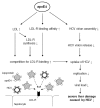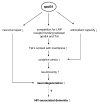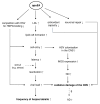Apolipoprotein E genotype and hepatitis C, HIV and herpes simplex disease risk: a literature review
- PMID: 20109174
- PMCID: PMC2830997
- DOI: 10.1186/1476-511X-9-8
Apolipoprotein E genotype and hepatitis C, HIV and herpes simplex disease risk: a literature review
Abstract
Apolipoprotein E is a polymorphic and multifunctional protein with numerous roles in lipoprotein metabolism. The three common isoforms apoE2, apoE3 and apoE4 show isoform-specific functional properties including different susceptibilities to diseases. ApoE4 is an accepted risk factor for Alzheimer's disease and cardiovascular disorders. Recently, associations between apoE4 and infectious diseases have been demonstrated. This review summarises how apoE4 may be involved in the infection incidence and associated pathologies of specific infectious diseases, namely hepatitis C, human immunodeficiency virus disease and herpes simplex.ApoE4 seems to be protective against chronic hepatitis C virus infection and retards fibrosis progression. In contrast apoE4 enhances the fusion rate of human immunodeficiency virus with target cell membranes, resulting in accelerated cell entry and faster disease progression. Its association with human immunodeficiency virus-associated dementia remains controversial. Regarding herpes simplex virus infection, apoE4 intensifies virus latency and is associated with increased oxidative damage of the central nervous system, and there is some evidence that herpes simplex virus infection in combination with the apoE4 genotype may be associated with an increased risk of Alzheimer's disease. In addition to reviewing available data from human trials, evidence derived from a variety of cell culture and animal models are considered in this review in order to provide mechanistic insights into observed association between apoE4 genotype and viral disease infection and pathology.
Figures




Similar articles
-
Differential Signaling Mediated by ApoE2, ApoE3, and ApoE4 in Human Neurons Parallels Alzheimer's Disease Risk.J Neurosci. 2019 Sep 11;39(37):7408-7427. doi: 10.1523/JNEUROSCI.2994-18.2019. Epub 2019 Jul 22. J Neurosci. 2019. PMID: 31331998 Free PMC article.
-
In Thai Nationals, the ApoE4 Allele Affects Multiple Domains of Neuropsychological, Biobehavioral, and Social Functioning Thereby Contributing to Alzheimer's Disorder, while the ApoE3 Allele Protects Against Neuropsychiatric Symptoms and Psychosocial Deficits.Mol Neurobiol. 2018 Aug;55(8):6449-6462. doi: 10.1007/s12035-017-0848-0. Epub 2018 Jan 6. Mol Neurobiol. 2018. PMID: 29307083
-
Apolipoprotein E and oxidative stress in brain with relevance to Alzheimer's disease.Neurobiol Dis. 2020 May;138:104795. doi: 10.1016/j.nbd.2020.104795. Epub 2020 Feb 6. Neurobiol Dis. 2020. PMID: 32036033 Free PMC article. Review.
-
Interaction of nascent ApoE2, ApoE3, and ApoE4 isoforms expressed in mammalian cells with amyloid peptide beta (1-40). Relevance to Alzheimer's disease.Biochemistry. 1997 Aug 26;36(34):10571-80. doi: 10.1021/bi9626362. Biochemistry. 1997. PMID: 9265639
-
Implications of apolipoprotein E genotype on inflammation and vitamin E status.Mol Nutr Food Res. 2010 May;54(5):623-30. doi: 10.1002/mnfr.200900398. Mol Nutr Food Res. 2010. PMID: 20183830 Review.
Cited by
-
Insights into the Novel Therapeutics and Vaccines against Herpes Simplex Virus.Vaccines (Basel). 2023 Jan 31;11(2):325. doi: 10.3390/vaccines11020325. Vaccines (Basel). 2023. PMID: 36851203 Free PMC article. Review.
-
The potential applications of Apolipoprotein E in personalized medicine.Front Aging Neurosci. 2014 Jul 8;6:154. doi: 10.3389/fnagi.2014.00154. eCollection 2014. Front Aging Neurosci. 2014. PMID: 25071563 Free PMC article. Review.
-
Herpesviridae, Neurodegenerative Disorders and Autoimmune Diseases: What Is the Relationship between Them?Viruses. 2024 Jan 17;16(1):133. doi: 10.3390/v16010133. Viruses. 2024. PMID: 38257833 Free PMC article. Review.
-
Human apolipoprotein E promotes hepatitis B virus infection and production.PLoS Pathog. 2019 Aug 8;15(8):e1007874. doi: 10.1371/journal.ppat.1007874. eCollection 2019 Aug. PLoS Pathog. 2019. PMID: 31393946 Free PMC article.
-
Demographic and Lifestyle Characteristics, but Not Apolipoprotein E Genotype, Are Associated with Intelligence among Young Chinese College Students.PLoS One. 2015 Nov 17;10(11):e0143157. doi: 10.1371/journal.pone.0143157. eCollection 2015. PLoS One. 2015. PMID: 26574747 Free PMC article.
References
-
- Rall SC Jr, Weisgraber KH, Mahley RW. Human apolipoprotein E. The complete amino acid sequence. J Biol Chem. 1982;257(8):4171–4178. - PubMed
-
- Basu SK, Ho YK, Brown MS, Bilheimer DW, Anderson RG, Goldstein JL. Biochemical and genetic studies of the apoprotein E secreted by mouse macrophages and human monocytes. J Biol Chem. 1982;257(16):9788–9795. - PubMed
-
- Newman TC, Dawson PA, Rudel LL, Williams DL. Quantitation of apolipoprotein E mRNA in the liver and peripheral tissues of nonhuman primates. J Biol Chem. 1985;260(4):2452–2457. - PubMed
Publication types
MeSH terms
Substances
LinkOut - more resources
Full Text Sources
Medical

